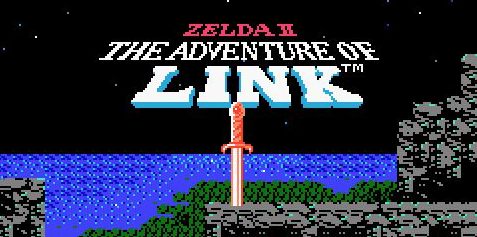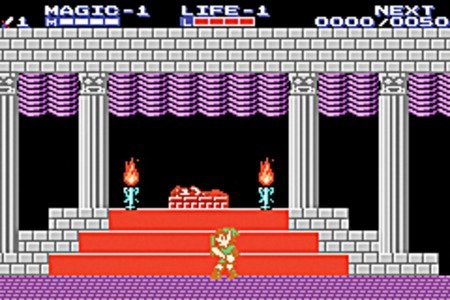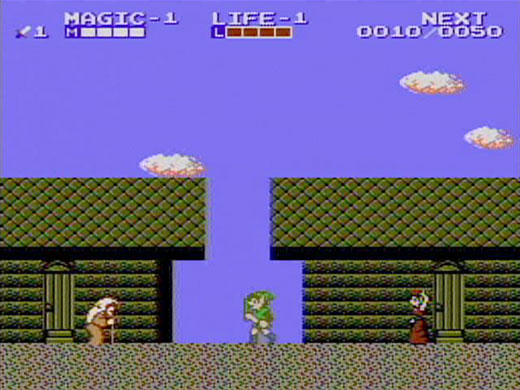
Republished article from our 8-bit Week, highlighting a Zelda memory.
In a meeting room, somewhere at Nintendo of Japan HQ, Shigeru Miyamoto meets with his team to discuss the sequel to the wildly popular Legend of Zelda. Miyamoto sits at the head of a long business table, lined with his closest advisers and associates. The following has been translated to English for your convenience.
“Mr. Miyamoto, we’d like to congratulate you on your success with The Legend of Zelda. Right now, it’s the first NES game to sell over 1 million units. It would be wise to strike while the iron is hot and follow-up with a sequel while it’s still fresh in our fans’ minds.”
“Thank you. And I agree, we must release a sequel soon.”
“We’ll get the team on it. So, we put Link in a new land, scramble the overworld up, and insert new labyrinths. Save. Print. Right?”
“Well, that’s not quite what I had in mind. I was thinking of boxes.”
“Boxes, sir?”
“Boxes. Instead of hearts on top of the screen, we have boxes to represent Link’s life. Also, we need points! Lots of points! Like, if Link were to do something like vanquish a foe, he could get experience points that make him stronger… kind of like in these role-playing games they have now.”
“I see. I’ll make note of that. Is that it, sir?”
Little did Shigeru Miyamoto’s associates and yes-men know that that question would set off a myriad of “ohs,” “ahs,” and raised eyebrows. It’s fitting that in Zelda II: The Adventure of Link, our hero would be in search of the Triforce of Courage because within this title is one of Miyamoto’s (and the 8-bit era’s) greatest displays of courage. But with this bravery comes one of the 8-bit era’s greatest flaws.

Often times during the 8-bit era, a game tape wasn’t enough to fully experience the game. Usually, one would need flip through an instruction booklet to get important notes on gameplay and story. If you just popped in Zelda II without reading through the manual, you’d automatically be missing out on an epic story. Many years after Ganon’s defeat, a teenaged Link must set out to save Princess Zelda. Zelda had fallen victim to a sleeping spell that Link has to break by finding the Triforce of Courage. Unfortunately for Link, Ganon’s minions are out for revenge because killing Link and sprinkling his blood on their lord’s ashes would resurrect the Prince of Darkness.
Heavy. Isn’t it?
Zelda II was a gutsy move by Nintendo. They could have gone through the Lost Levels route with Zelda II, but they didn’t. The sequel was built from scratch and boasts some heavy structural differences from its predecessor. A simple over-the-head point of view was implemented in the world map, but most of the gameplay took place in a side-scrolling action screen that was triggered when Link walked into a town, cave, or was ambushed by an enemy on the world map.
![Zelda-II-The Adventure-of-Link_thumb[3]](https://www.sidequesting.com/wp-content/uploads/Zelda-II-The-Adventure-of-Link_thumb3.jpg)
The action screen brought elements from different genres into the game. Battles now took place from a side-scrolling point of view, there were platforming elements, and being victorious in battle resulted in gaining experience points. The player was immediately treated to a clever mixture of a 2D platformer, an action game, and an RPG.
I thought that implementing experience points was a good way to really let me appreciate the battle system and stop me from running away from every enemy. Almost all of my successful Zelda II playthroughs required some light grinding since leveling up meant that I could strengthen my physical attacks, cast more magic spells, or improve my defense. Often times, I found myself having to put some thought towards which of the three I would be choosing.
Will I have to beef up my defense before entering this next palace? Will I have to cast a lot of magic? Questions like these were important since casting magic spells often meant the difference between (losing a) life and death. Magic spells in Zelda II all served a purpose. Some spells helped you platform by allowing you to fly or jump higher. Other spells gave you more gas in a fight by boosting your defense or replenishing health.

Other additions to the Zelda formula included the addition of towns, fetch quests, and lives. Towns and fetch quests added more depth to the “adventuring” side of the game. The addition of lives, however, doesn’t add much to the experience and only makes thing tedious. When you lose your three lives, you’re forced to go back and start off where you did at the beginning of the game (any items and spells you gained remained with you).
Did this new formula work? Sales figures suggest that it did because Zelda II was as much of a success as its predecessor. But when you ask your friends about this game, have any of them actually taken the time to learn the ins and outs to solve it? I had this game in 1991, when I was in kindergarten. I beat it when I was in 6th grade, well after the release of the SNES. Zelda II is/was very difficult. Although the mixture of genres were harmonious, the player lacked guidance.

This lack of guidance was what made the game as hard as it was and was one of the biggest flaws of many games in the 8-bit era. It went back to the fact that reading the instruction manual was sometimes a requirement for getting a complete experience out of your cartridge. And in most cases, this wasn’t even enough to help you progress through the game.
One famous fetch quest involved getting the River Man to lower a bridge for me. I had to search for a man named Bagu in a certain patch of forest so that I could take his note to the River Man. If I didn’t know to speak to the right person, I’d have no idea how to find Bagu. And even if I did, I often died from the onslaught of battles that rained down on me as I scoured this patch of forest for the correct tile.

Zelda II is often forgotten, but it’s one of my favorite Zelda games. This game might be best approached as a literary work that you would study in your high school or undergraduate English class. Like Mozart, Zelda II wasn’t appreciated by everybody in its time, as most people probably left the game unfinished. However, it’s worth experiencing, playing, and learning today.
Shigeru Miyamoto really went out on a limb when he designed Zelda II: The Adventure of Link because he could have played it safe, but he didn’t. Instead, he took elements from various videogame genres and incorporated them into a Zelda game. More importantly, the components of each genre that he borrowed worked well with one another to create something that was larger than the sum of its parts. Like most games in the 8-bit era, Zelda II does leave the player with little to no guidance through the adventure.
Regardless, you can’t deny the fact that this game has guts. If you can muster up some of your own and overcome this lack of guidance (or use a GameFAQ), I have no doubt that you can go back and appreciate the experience that Miyamoto intended you to have with this game.


No Comments